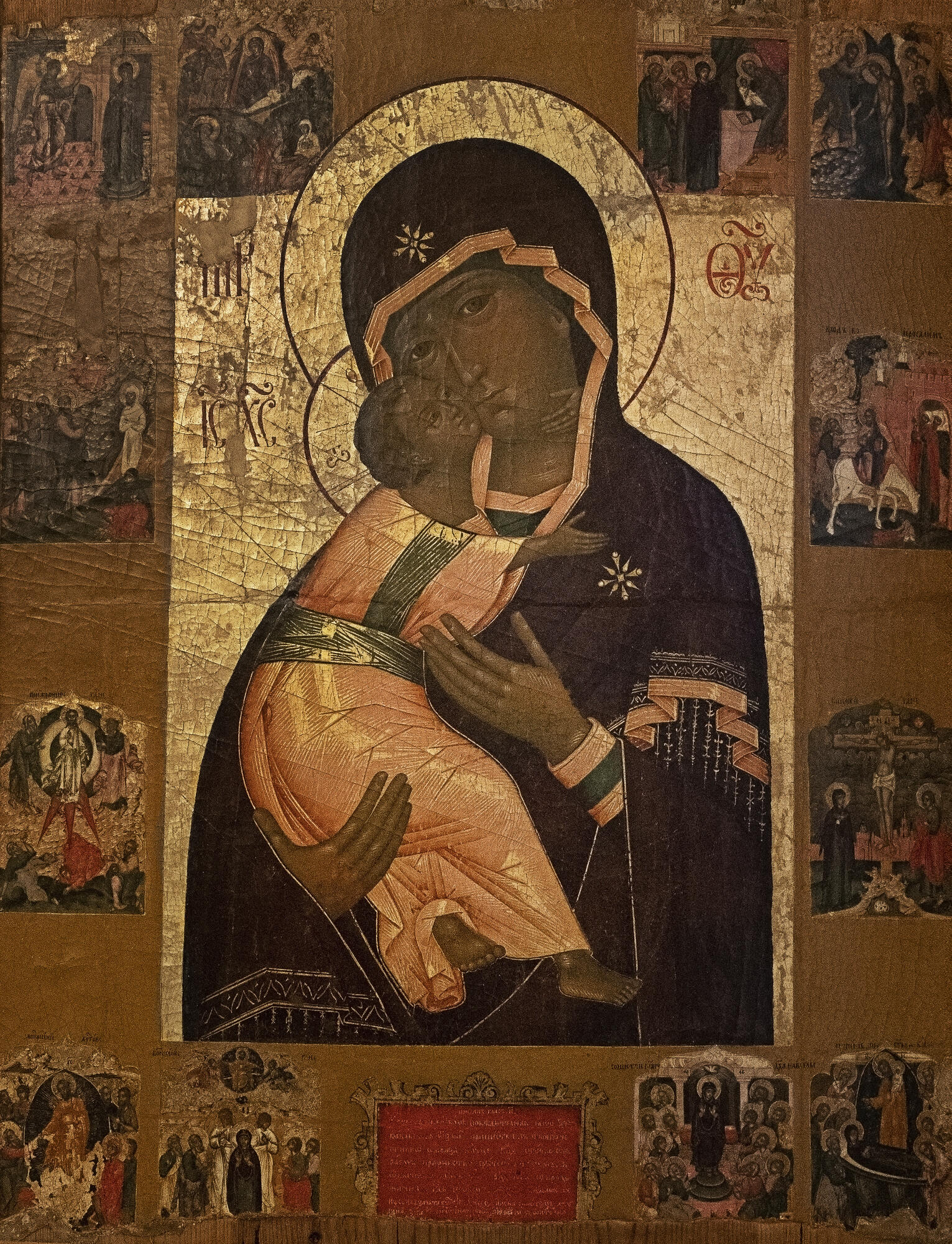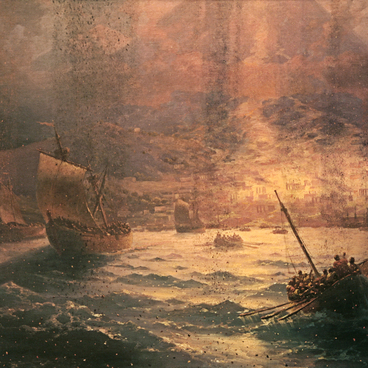The Vladimir Icon of the Mother of God with Scenes of Feasts from the collection of the Rostov museum is a copy of the 12th century Vladimir icon.
According to holy tradition, Our Lady of Vladimir was painted by Luke the Evangelist in Constantinople. In 1130, it was brought to Kiev, and later on to Vladimir where the image was particularly revered. Since 1480, the icon was housed in the Assumption Cathedral of the Moscow Kremlin. As of 1930, it was included in the collection of the State Tretyakov Gallery, and in 1999 the icon was transferred to the Church of St. Nicholas in Tolmachi, that is both a Russian Orthodox church and a museum.
Orthodox Christians consider the Vladimir Icon of the Mother of God to be miracle working. Numerous important events in the history of Russia are associated with this image. Therefore, during many centuries icon painters have adhered to the Old Russian painting tradition and created copies of this image, in which they retained the composition and imagery of the original icon.
The Vladimir Icon of the Mother of God with Scenes of Feasts is an example of the ‘Eleousa’ iconographic type, which is translated from Greek into Russian as ‘Showing mercy’. In Russia, this type of image was called ‘Tenderness’. These icons depict the infant Christ and Mary in a moment of mutual tenderness: Jesus embraces the Virgin and presses his cheek against hers.
Mary’s face is sad, as she foresees the tragic fate awaiting her son. The icon painter endowed the Virgin with great humanity and tenderness. Her features correspond to the most ancient ideas about her appearance. According to the Apocrypha, the Mother of God had an oval swarthy face, wheat-colored hair, and almond-shaped eyes.
Color plays an important role in the icon. The gold background of the icon symbolizes the eternal light, the Kingdom of God. The crimson shade of a long female cloak — the Virgin’s veil — emphasizes the regality. In Byzantium, this type of clothes was considered an attribute of royal power. The stripe on the sleeve of Jesus — the Roman clavus — is also a sign of noble descent.
The Vladimir Icon of the Mother of God with Scenes of Feasts consists of the central part and the miniatures surrounding it. The middle part, called ‘srednik’, is the central part of the icon depicting the Virgin and the Child. It is surrounded by the miniatures — small images depicting the main Christian religious holidays. The miniature stories should be followed from left to right and from top to bottom, starting with the Annunciation and through to the Assumption.
According to holy tradition, Our Lady of Vladimir was painted by Luke the Evangelist in Constantinople. In 1130, it was brought to Kiev, and later on to Vladimir where the image was particularly revered. Since 1480, the icon was housed in the Assumption Cathedral of the Moscow Kremlin. As of 1930, it was included in the collection of the State Tretyakov Gallery, and in 1999 the icon was transferred to the Church of St. Nicholas in Tolmachi, that is both a Russian Orthodox church and a museum.
Orthodox Christians consider the Vladimir Icon of the Mother of God to be miracle working. Numerous important events in the history of Russia are associated with this image. Therefore, during many centuries icon painters have adhered to the Old Russian painting tradition and created copies of this image, in which they retained the composition and imagery of the original icon.
The Vladimir Icon of the Mother of God with Scenes of Feasts is an example of the ‘Eleousa’ iconographic type, which is translated from Greek into Russian as ‘Showing mercy’. In Russia, this type of image was called ‘Tenderness’. These icons depict the infant Christ and Mary in a moment of mutual tenderness: Jesus embraces the Virgin and presses his cheek against hers.
Mary’s face is sad, as she foresees the tragic fate awaiting her son. The icon painter endowed the Virgin with great humanity and tenderness. Her features correspond to the most ancient ideas about her appearance. According to the Apocrypha, the Mother of God had an oval swarthy face, wheat-colored hair, and almond-shaped eyes.
Color plays an important role in the icon. The gold background of the icon symbolizes the eternal light, the Kingdom of God. The crimson shade of a long female cloak — the Virgin’s veil — emphasizes the regality. In Byzantium, this type of clothes was considered an attribute of royal power. The stripe on the sleeve of Jesus — the Roman clavus — is also a sign of noble descent.
The Vladimir Icon of the Mother of God with Scenes of Feasts consists of the central part and the miniatures surrounding it. The middle part, called ‘srednik’, is the central part of the icon depicting the Virgin and the Child. It is surrounded by the miniatures — small images depicting the main Christian religious holidays. The miniature stories should be followed from left to right and from top to bottom, starting with the Annunciation and through to the Assumption.



